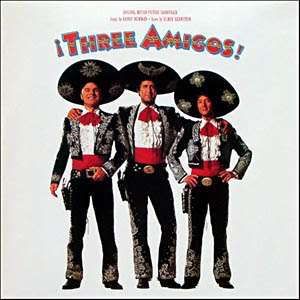By Ilene Palacios
Exhibits
A & B: Javier Bardem & Alejandro González Iñárritu:
Javier Bardem is known as a Spanish
actor born in the Canary Islands, an autonomous community off the coast of
Africa that fell under Spanish rule starting from the early 1400s. “Los
canarios” are usually also considered to be racially Spanish, but Canarian
dialects are distinct from Peninsular Spanish. He was the first Spanish actor
to be nominated for the Academy Award for Best Actor in a Leading Role for his
part in Before Night Falls. He was
also the first to win for Best Supporting Actor, which he won for his haunting
role in the Cohen brothers’ adaptation of No
Country for Old Men in 2007.
Bardem got a second Best Actor
nomination this year for his role in Mexico City-born director Alejandro
González Iñárritu’s (a.k.a. “el Negro” for his dark skin) film Biutiful, nominated for Best Foreign
Language Film. Iñárritu was the first Mexican to be nominated for Best
Director. His four feature films have included a variety of languages, Spanish
above all, have been nominated for a dozen Oscars, and his first feature 2000’s
Amores Perros, was also nominated for
Best Foreign Language Film. His second most recent film Babel, was nominated for seven awards including Best Motion Picture
and Best Director.
Exhibits Aₐ
& Bₐ: Javier and Alejandro, Marked
Being
un-American/foreigners/Spanish-speakers, etc., there are a few ways, outside of
their work per se that Javier Bardem and Alejandro González Iñárritu have been
marked. Here are examples for each of them.
Aₐ In response to an article by the
Hollywood Reporter:
“Last September the Hollywood Reporter guessed as much when
it published a story titled “Whitest
Oscars in 10 years,” warning
everyone that no actors of color were being considered for this year’s top
prizes. This year’s awards does
include one person of color, Javier Bardem from Spain who starred in
“Biutiful.”…
Grammatical errors aside, this post
calls Javier Bardem a ‘person of color’ – which, being
Spanish/Canarian/European, he is not. It is difficult to tell here if the
writer was mapping his native language of Spanish onto his ‘color’ or race or
if his foreignness, his being not (White) American was to blame for this faux
pas.
Being
an actor that does work in both English and Spanish, Javier’s imperfect use of
English and his ‘natural’ use of Spanish is a source of anxiety for some. In
his interview after
winning Best Supporting Actor (for an American movie filmed in English) in 2007
one journalist starts off by saying to Bardem, “We want you to share some of
this joy…in English” and laughing.
If you are so
inclined to see that full interview:
Bₐ: Iñárritu, along with the two
other, according to the NY Times, of Mexico’s “most successful, acclaimed
directors” formed a sort of production conglomerate called Cha Cha Cha films.
Hollywood has taken it upon itself to thus call this group “The Three Amigos”.
Ironically, this trio created the conglomerate to use its range of skills and
style as a point of leverage in Hollywood, i.e. for American-produced films.
Talk about a triple whammy of a culture and language suffering erasure, appropriation and mildly offensive iconization...and...hmm actually with that pose, I see the resemblance...
Marking
and Not Marking Films and People through the “Film in a Foreign Language” Oscar
Category
Awarding people and films based on a
particular set of U.S. standards that utilize somewhat arbitrary categories can
be limiting and perhaps problematic. Things can get even more muddled and
ambiguous when race, nationality and language come into play. I doubt many
people would claim that the various participants of the Academy Awards are
representative, be they various ethnic, racial and gender groups within the
U.S., people from countries around the world or speakers of different
languages. The Best Foreign Language Film category, created in 1956, seems to
aim to address race, nationality and language all in one, but it may be the
most limiting and inconsistent category of all, and they way it plays out seems
to be based on a number of intertwining inconsistencies, assumptions and folk
notions.
For instance:
1)
The category assumes (U.S.) English as the
Standard language for film
2)
The nominees for the category are chosen not
by language(s) but by country in/from which a film is produced (although many
American films nowadays are physically and artistically made [e.g. filmed,
edited] internationally)
3)
A country is allowed to pick only one film to
represent it, i.e. linguistically, which, coupled with events and notions of
the film, could lead to the film being an reference for iconization and fractal
recursivity related to the country’s people and erasure of dialects
and other language use in that country
4)
Even though a film can include multiple
languages and dialects of a language, as well as multiple countries in which it
is produced, usually one language in one form is chosen for the films
The Best Foreign Language Film
category seems not only to try to bear and pass down the burden or
representation of the entire world, but also to map and overlap nationality or
country with language together, and might even run the risk of dragging in
assumptions about ethnicity and race in with the mix. There are many points of fractal recursivity happening and it is
difficult to see at what point of difference the process began.
Iñárritu’s film Babel was nominated for Best Picture, not Best Foreign Language
Film, even though its director is Mexican and it contained Arabic, Spanish,
Japanese, a Japanese variety of Sign Language (in addition to English), because
it was an American-produced film. The
first film Javier Bardem was nominated for, Before
Night Falls, contained English, Spanish, Russian and French, but he was
nominated for Best Supporting Actor among other English-speaking actors, and
won. He also was nominated for Best Actor for Iñárritu’s Biutiful, a Foreign Language Film nominee.
This inconsistency and erasure that
occurs in this category come somewhat to light when the Best Foreign Language
Film nominees are presented at the Academy Awards show. This occurs in the form
of reading out the nominees’ film titles in English or the film’s own, “foreign” language:
Perhaps the actress couldn’t
pronounce those two film titles she read in English, or maybe it was how the
films were marketed. The actress reading out the nominees here reads the
nominees out, introducing them by saying, “From (insert country here)” instead
of “In (insert language here)”, and reads their titles are written on the
screen behind her. The Milk of Sorrow (in
Spanish, La teta asustada, literally
“the frightened breast”) and The White
Ribbon (in German, Das Weisse Band)
are read out in the language and country the film represents.
The White
Ribbon is
actually an Austrian-German production, but it represented Germany – and the
German language. The Milk of Sorrow
was produced by both Peru and Spain and contained both Spanish and Quechua, but
it only represented one country and one language, Peru and Spanish, respectively.
One Nation,
One Language, One People…One Category?
Based
on these examples, one might conclude the following about the Academy Awards
and its categorizations and conceptions about language and nationality (and
perhaps following that thread, race):
·
Actors’ ‘foreignness’
(I.e. they are ‘foreign-made’, ‘produced’ in another country) can mark them,
especially in relation to U.S. folk notions and ideologies about ‘normal’ or
‘appropriate’ language use, nationality and race in relation to English/American/White
·
Acting
whether done in English or another language, is thought of as more universal,
language-less – perhaps ironically; separate categorization for actors is not
necessary (because actors act like someone else anyway)
·
A film can
contain (a) “foreign” language(s)/actors/directors/filming/editing, but isn’t really considered as such unless it’s produced
in another country, and thus would require a separate category of nomination.
·
Language and
Nationality are almost interchangeable terms by which a film can be defined
·
The Academy
Awards’ (i.e. the U.S.) language ideology of one language/nation/people are imposed on Foreign Language nominees and assumes a similar language ideology applies for every country in the world; the nominated films must adhere to the Academy's rules and be the sole choice of one country with one language to represent that country -- this
has implications for what a film represents of a country’s people as being of a particular monolingual (i.e. one dialect too),
monoethnic, and perhaps monoracial essence
o
Perhaps in
line with the devaluation of Bilingualism in the U.S. and valuation of
“Standard English”?
o
Probably
erase other countries’ ideologies about language and its use and prevalence
·
A language
and a Country can be commodified and represented in a film
The only country that can be said to
predominantly speak English, Canada, was nominated for Best Foreign Language
Film for a film made in that country’s dialect of French. Never has a film from
Britain, Australia, New Zealand, etc. been nominated because mainly English is spoken there; they are
foreign countries, but they are English-speaking countries so they cannot qualify for this award though the award is given out to filmmakers of a country, not who are speakers of a language.
One might wonder what might happen if
Pakistan and India, which list English as an official language, ever submitted
an English-language film if it would nominated for the Best Foreign Language
Film Category. Would their foreignness and distance of geography, ethnicity and
race trump the similarity of language then? How much would such films need to fit
the ‘Foreign Language Film profile’, the U.S./Hollywood ideology about language, in order to even be considered for nomination?
Additional
References
http://www.nytimes.com/2009/04/26/movies/26roht.html?_r=1



No comments:
Post a Comment